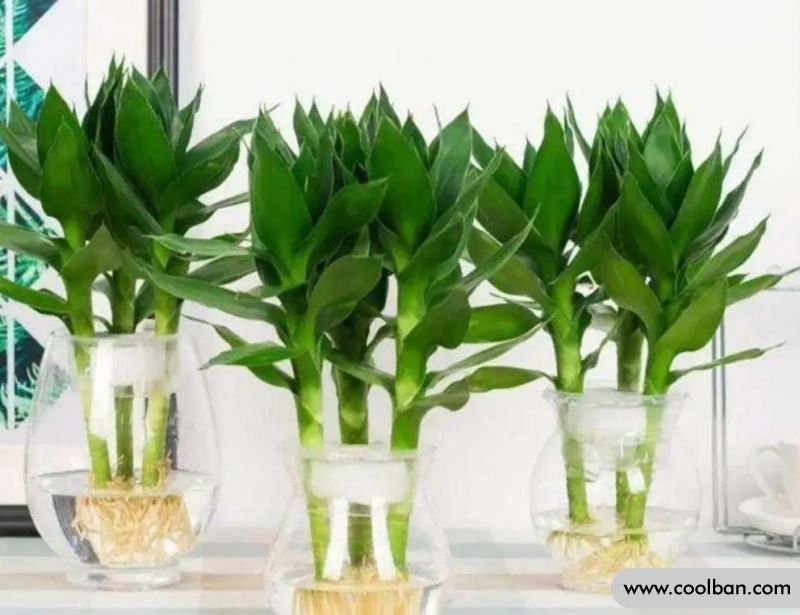How to Plant Lucky Bamboo
Lucky Bamboo is relatively tolerant to fertilizers. Water-supporting Lucky Bamboo can change the water every two weeks and add some potassium dihydrogen phosphate to ensure normal nutrient absorption.

What should I do if the leaves of Lucky Bamboo turn yellow?
There are many conditions for the leaves of Lucky Bamboo to turn yellow. Too much water, too much sunlight, and lack of fertilizer can cause leaves to turn yellow. So what can be done to improve it?
Improvement 1: The leaves are mostly yellow because of the water.
The new leaves of Lucky Bamboo are dark yellow and dull, the old leaves have no obvious change, and the branches are small yellow-green, which are signs of overwatering. We can move the lucky bamboo to a ventilated and shady place, and then put it back in the pot when the soil is dry.
Improvement 2: The leaves are yellow due to insufficient sunlight.
The yellow color in this case means that the leaves do not get sunlight, and the whole leaves dry up and fall off, so let the lucky bamboo supplement the sunlight.
Improvement 3: Leaves turn yellow due to lack of water.
A dry yellow that is deficient in water is not the same as a yellow that is too watery. Withered yellow is the dry and yellowing of the edges of the leaves, and the old leaves are dry and fall off. This shows that the watering is too much and can be appropriately reduced.
Improvement 4: The leaves turn yellow due to too much sunlight.
Cloudy yellow leaves are yellow spots on the sun-facing part of the leaves. This is caused by too much sunlight. You can move Lucky Bamboo to a shady place.
Improvement 5: The leaves are yellow due to too much or too little fertilizer.
Excessive fertilization, the new leaves of Lucky Bamboo are dry and brown, the leaves are thick and dull, concave and convex, and the old leaves become brown and fall off. Fertilization should be stopped at this time, and some fertilizers can be washed with water. If fertilizer is missing, leaves are growing and new leaves are lighter in color, the soil can be checked and replaced. Or apply some nitrogen fertilizer regularly.

How to raise lucky bamboo in winter
In winter, the temperature is low, and the best growth temperature of Lucky Bamboo is 20-29 degrees. If the temperature is too high, development will be slow; if the temperature is too low, frost will form. To raise lucky bamboo in winter, the temperature should be kept above 10 degrees. Stop fertilizing in winter and water less. The most important thing to keep lucky bamboo in winter is to pay attention to prevent frostbite. In the north, raising lucky bamboo should not be placed outdoors, and the indoor temperature should not be lower than 10 degrees, otherwise the leaves will turn yellow, and yellow-brown spots will appear on the tips and edges of the leaves.
In winter, you can choose water, soil, or bottle. In winter, the water for Lucky Bamboo is basically changed once a week.
How to raise lucky bamboo in water
To raise Lucky Bamboo in water, it is necessary to change the water frequently and prune the roots in the initial stage. After the lucky bamboo takes root, there is no need to change the water frequently, and the water can be added in time after the water evaporates. So how does Lucky Bamboo grow in water?
Method 1: If you are just starting to grow Lucky Bamboo, before inserting the bottle, remove the leaves at the root, which will allow the bamboo to grow better. As for how much to remove, it depends on the size of the bottle.
Method 2: The water in the bottle can reach one third of the bottle, but not more than two thirds. The tap water must be precipitated first to reduce the chlorine in the water and ensure the normal growth of Lucky Bamboo.
Method 3: Before the lucky bamboo takes root, change the water every three days. After rooting, you can add water directly to the bottle. In hot weather, you can use a watering can to spray water directly on the leaves.
Method 4: Lucky bamboo is relatively tolerant to fertilizer. Water-supporting Lucky Bamboo can change the water every two weeks and add some potassium dihydrogen phosphate to ensure normal nutrient absorption.
How to grow lucky bamboo in the soil
Method 1: Choose loose soil or fertile paddy fields or sloping fields for planting. Because the soil is relatively moist, if it is too dry, it will cause the leaves to turn yellow. Water every 2-3 days.
Method 2: The growth temperature of Lucky Bamboo is best kept at 20-28 degrees. If it's summer, spray the leaves with water, and watch out for frost in winter.
Method 3: Lucky Bamboo is suitable for semi-shade, strong sunlight will make the leaves turn yellow and fall off.
Method 4: The best planting time for Lucky Bamboo is April-September, and the peak season is May-September. You can add granular compound fertilizer to the soil of Lucky Bamboo every month to maintain growth.